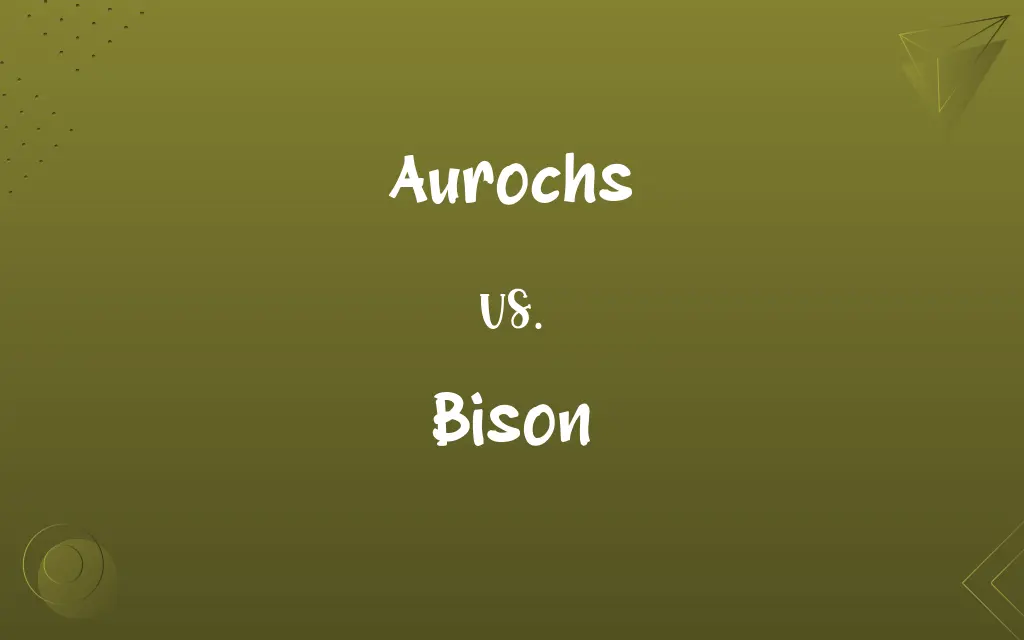Aurochs vs. Bison: Know the Difference

By Shumaila Saeed & Dua Fatima || Updated on March 5, 2024
Aurochs were ancient wild cattle native to Eurasia, now extinct, known for their large size and long horns, while Bison are large, still-existing wild cattle species found in North America and Europe, notable for their shaggy mane and massive head.

Key Differences
Aurochs were the ancestors of domestic cattle, flourishing in the grasslands of Europe, Asia, and North Africa until their extinction in the 17th century. Bison, on the other hand, are a symbol of the American West and consist of two species: the American bison and the European bison (or wisent), both of which have survived into the 21st century and are known for their robust build and thick fur.
Shumaila Saeed
Mar 05, 2024
The aurochs played a significant role in human history, being depicted in cave paintings and mentioned in various ancient texts, signifying their importance in prehistoric cultures. Bison have also been integral to the cultures and survival of Indigenous peoples of North America, providing food, clothing, and materials for shelter, whereas the relationship between humans and aurochs was more focused on domestication and hunting.
Dua Fatima
Mar 05, 2024
Aurochs were characterized by their long, slender horns that curved forwards, distinguishing them visually from bison. Bison's horns are shorter, curving upward and inward, which is part of their adaptation to fighting and defending against predators in the wild.
Shumaila Saeed
Mar 05, 2024
The extinction of the aurochs in the 1620s was due to a combination of factors, including overhunting and habitat loss. Bison, while they faced near extinction in the late 19th century due to excessive hunting and the expansion of agriculture, have been the subject of successful conservation efforts, particularly the American bison, which has rebounded from the brink of extinction.
Dua Fatima
Mar 05, 2024
In terms of temperament, aurochs were described as fierce and unmanageable, which contributed to their extinction as wild animals. Bison, although powerful and potentially aggressive, especially during the mating season, have shown a capacity to be conserved in both wild settings and reserves, reflecting differences in their interactions with humans over time.
Shumaila Saeed
Mar 05, 2024
ADVERTISEMENT
Comparison Chart
ADVERTISEMENT
Aurochs and Bison Definitions
Aurochs
Ancient wild cattle species, now extinct.
The aurochs once roamed freely across the grasslands of Eurasia.
Hifza Nasir
Mar 05, 2024
Bison
Large, shaggy-haired wild cattle of North America and Europe.
Bison herds once covered the Great Plains of the United States.
Shumaila Saeed
Mar 05, 2024
Aurochs
Ancestor of domestic cattle.
The domestication of aurochs was a significant event in human history.
Hifza Nasir
Mar 05, 2024
Bison
Subject of conservation success.
American bison populations have rebounded thanks to protective laws.
Hifza Nasir
Mar 05, 2024
Aurochs
Extinct in the 17th century.
The last known aurochs died in the Jaktorów Forest, Poland.
Shumaila Saeed
Mar 05, 2024
ADVERTISEMENT
Bison
Integral to Indigenous cultures in North America.
Bison provided essential resources for Plains Indigenous peoples.
Shumaila Saeed
Mar 05, 2024
Aurochs
Symbolized in ancient art and culture.
Aurochs are featured prominently in Paleolithic cave art.
Dua Fatima
Mar 05, 2024
Bison
Includes American and European species.
The European bison, or wisent, is found in isolated forest areas.
Shumaila Saeed
Mar 05, 2024
Aurochs
Known for impressive size and long horns.
Aurochs were depicted with long, forward-curving horns in cave paintings.
Shumaila Saeed
Mar 05, 2024
Bison
Notable for massive head and robust build.
Bison use their massive heads to plow through snow in search of grass.
Shumaila Saeed
Mar 05, 2024
Aurochs
Large recently extinct long-horned European wild ox; considered one of the ancestors of domestic cattle
Shumaila Saeed
Oct 19, 2023
Bison
A bovine mammal (Bison bonasus) of Europe, similar to the American bison but with a somewhat smaller head and longer horns; a wisent.
Shumaila Saeed
Oct 19, 2023
Aurochs
A wild ox (Bos primigenius) of Europe, northern Africa, and western Asia that became extinct in the 17th century and is believed to be the ancestor of domestic cattle. Also called urus.
Shumaila Saeed
Oct 19, 2023
Bison
Any of several large shaggy-maned humped bovids having large heads and short horns
Shumaila Saeed
Oct 19, 2023
Bison
A bovine mammal (Bison bison) of western North America, having large forequarters, a shaggy mane, and a massive head with short curved horns; a buffalo.
Shumaila Saeed
Oct 19, 2023
Repeatedly Asked Queries
What are aurochs?
Aurochs were an ancient species of large wild cattle that are now extinct.
Dua Fatima
Mar 05, 2024
Are bison still alive today?
Yes, bison still exist today, with populations in North America and Europe.
Shumaila Saeed
Mar 05, 2024
How have bison impacted Indigenous cultures?
Bison were crucial to the survival and culture of many Indigenous peoples in North America, providing food, clothing, and materials.
Shumaila Saeed
Mar 05, 2024
Why did the aurochs go extinct?
The aurochs went extinct due to overhunting and habitat loss.
Hifza Nasir
Mar 05, 2024
How do the horns of bison and aurochs compare?
Aurochs' horns were long and curved forwards, while bison's horns are shorter, curving upward and inward.
Shumaila Saeed
Mar 05, 2024
What distinguishes bison from aurochs?
Bison are characterized by their large size, shaggy mane, and massive head, whereas aurochs were known for their long, slender horns and larger stature.
Shumaila Saeed
Mar 05, 2024
What efforts have been made to conserve bison?
Conservation efforts for bison have included protected reserves and laws to prevent overhunting.
Shumaila Saeed
Mar 05, 2024
Were aurochs used in agriculture?
Aurochs were domesticated into what we now recognize as modern cattle, playing a role in the development of agriculture.
Shumaila Saeed
Mar 05, 2024
How did the aurochs influence human culture?
Aurochs were significant in ancient cultures, depicted in art and literature, symbolizing strength and wildness.
Shumaila Saeed
Mar 05, 2024
Did bison and aurochs occupy the same habitats?
No, aurochs were native to Europe, Asia, and North Africa, while bison are found in North America and parts of Europe.
Dua Fatima
Mar 05, 2024
What is the significance of bison in American history?
Bison are a symbol of the American West and were vital to the ecosystem of the Great Plains.
Shumaila Saeed
Mar 05, 2024
Can bison and aurochs interbreed?
No, they cannot interbreed as aurochs are extinct.
Shumaila Saeed
Mar 05, 2024
Are there any living descendants of the aurochs?
All modern domestic cattle are considered descendants of the aurochs.
Hifza Nasir
Mar 05, 2024
What is the European bison called?
The European bison is also known as the wisent.
Shumaila Saeed
Mar 05, 2024
What is the current status of bison populations?
Bison populations are currently stable, thanks to conservation efforts, but some species remain endangered.
Shumaila Saeed
Mar 05, 2024
Share this page
Link for your blog / website
HTML
Link to share via messenger
About Author
Written by
Shumaila SaeedShumaila Saeed, an expert content creator with 6 years of experience, specializes in distilling complex topics into easily digestible comparisons, shining a light on the nuances that both inform and educate readers with clarity and accuracy.
Co-written by
Dua Fatima








































































